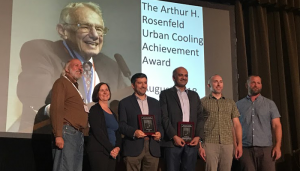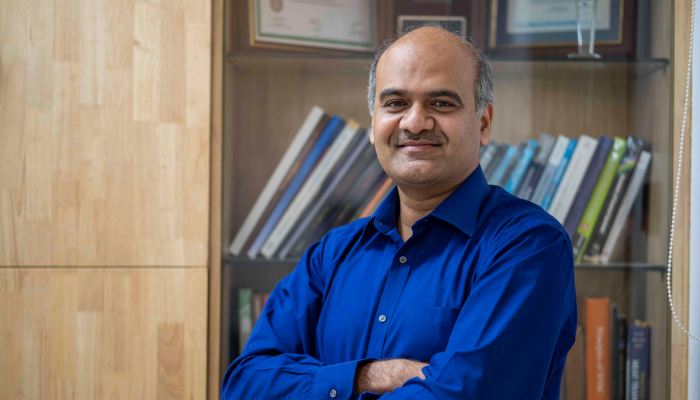When the Telangana Principal Secretary Arvind Kumar made a statement at the Global Climate Action Summit in San Francisco last month that Hyderabad intends to convert 1,000 buildings to ‘cool roofs’ as part of the city’s Heat Action Plan for next summer, Prof. Vishal Garg from the Building Science center at IIIT-H had reason to celebrate. We found out why in a freewheeling chat with the Professor who is winner of the inaugural Arthur Rosenfeld Urban Cooling Achievement award.
Serendipity. It’s a term that crops up often as Prof. Vishal Garg describes his tryst from being “a civil engineer, interested in energy efficiency” to a professor who heads the Center for IT in Building Science. “As a civil engineering student, I had created a model where I used optical fibres to harness sunlight for indoor illumination and presented it at ELECRAMA, an Indian Exhibition on electricity, where I secured the second place in research category, “ says Dr. Garg modestly. A chance visit to meet friends at IIT Delhi led him to the Center for Energy Studies there. Suitably impressed by the model presented at ELECRAMA, despite the absence of a Master’s degree, he was accepted into a PhD programme at IIT Delhi. He took courses on optical fibre communication, and optical workshop. “Unfortunately I could not secure funding to continue my research on optical fibre based daylighting. The funding proposal was approved but the money never came”, remarks Prof. Garg wryly. Since he was always interested in energy and automation and controls, he eventually completed his PhD in these areas.
Entrepreneur, Researcher, Professor
The entrepreneurial spark in the professor can be traced all the way back to his school days. Dr. Garg talks of how in the holidays that followed his 10th class exams, he advertised for and started an enterprise that covered a gamut of services from buying vegetables to railway tickets. “I used the network of my friends to cover the city. We couldn’t provide many services because I was overwhelmed by the calls. It was a big hit! I continued to receive calls even three years later asking for the services!”, says Dr. Garg with a chuckle. To further elaborate his entrepreneurial leanings, he mentions how a friend turned up at IIT Delhi when Dr. Garg was in the process of wrapping up his thesis, insisting on packing his bags and brought him back to Jaipur only to instate him as MD of a software company he had founded. “We started developing software for jewellers and carpet markers”. It was around the same time that a friend suggested IIIT-H as a viable career option for him. While teaching was definitely on his mind, being inspired by his mother who was a professor at the University of Rajasthan, Prof. Garg was skeptical about the choice of an institute that specialized in IT for his own field. “It was very clear that it didn’t make any sense to apply here. And it was my friend who drafted my application!”, Dr. Garg exclaims. When he interviewed for a faculty position at IIIT-H, he remarks that it was difficult to convince his family about his interest to move to Hyderabad. “Was it an accredited institution? No. Was there other faculty? No. Was it well-known? No. But I liked this place so much. There was so much positivity here, I made up my mind that even if they gave me no money and just covered my boarding and lodging, I would take up the offer!”, smiles Dr. Garg. In the year 2000, he joined IIIT-H and kickstarted the M.Tech programme in Building Sciences. There is now a Dual Degree programme with the focus on Building Sciences, MS by Research and PhD programmes too.

Building Energy Simulation
When buildings are constructed, one has to predict how the building will perform and how much energy it will consume. For this, a model has to be built and simulated with the help of software to test building’s performance. “Nearly everybody in the country who has learned building energy simulation is linked to Prof. Bansal from IIT Delhi. And I’m no exception,” remarks Prof. Garg. But the professor’s foray into simulation consultancy is anecdotal. It was prompted after he was questioned during a conference presentation if he had ever simulated a real building. The answer then was a ‘No’. This has since changed and now as a simulation evangelist, he has been involved in scores of projects and conducted many workshops on energy simulation. He has held lectures and trained the master trainers in the country. In 2017, he co-authored a workbook on Building Energy Simulation, – first of its kind, ready-reckoner for any student that details a step-by-step simulation process for energy optimization of commercial as well as residential buildings using computer software programs EnergyPlus and DesignBuilder. From being one of the handful of consultants across the country to bringing simulation into curriculum at the undergrad and postgrad level of universities, Dr. Garg says energy simulation has come a full circle.
Cool Roofs
When someone asked Dr. Garg around 14 years ago if he could experiment on “installing” a cool roof and studying its effects, he excitedly jumped at the offer. “I mistook it for radiant cooling thanks to the term “installing” that was used in the description,” he says. It was only later that he realised they meant, painting a roof white and comparing it to a regular roof. Since white roof reflects solar radiation, it was expected to have less heat transfer from roof to the internal spaces and thus be energy saving. Masking his initial disappointment with “something so obvious”, Dr. Garg nevertheless continued his experiments due to his commitment and says since then the learning has been tremendous. “From saving human lives, say in hospitals, or the lives of urban and rural poor who have no access to electricity, leave alone air conditioning, to reducing global warming, cool roofs have a wide spectrum of benefits,” says Dr. Garg. He explains how by reflecting light and infrared radiation, surfaces that are painted white reflect solar radiation, with the reflected radiation going out of the atmosphere into space. If radiation is absorbed by the surface, it gets re-radiated, getting converted into a long wave which is absorbed by the atmosphere. “Because of all this trapped heat, the earth’s surface gets heated up causing urban heat islands,” says Dr. Garg. To demonstrate the impact of cool roofs, Dr. Garg goes on to quote the ‘godfather of energy efficiency’, Arthur Rosenfeld, by stating, “If all eligible urban flat roofs in the tropics and temperate regions were gradually converted to white….That offsets the emissions of roughly 300 million cars for 20 years”. The professor lists various benefits such as lowering of average city temperatures, and reduction in pollution levels. “Studies have shown the benefits of cool pavements also. They include lowering of the outside air temperature, slowing the formation of smog,increasing visibility for drivers etc.,” says Dr. Garg.
Influencing Policy and Impacting Lives
Dr. Garg has been actively working with the local govt, trying to make it a mandate to have cool roofs. In fact, as part of the heat action plan for next summer, GHMC is trying to make at least 1,000 buildings ‘cool roofs’. A statement to this effect was made public by the Principal Secretary to the Govt. of Telangana at the Global Climate Action Summit held in San Francisco. Interestingly enough, the northern states of India such as Rajasthan and Gujarat have always had a tradition of whitewashing their homes annually to keep cool in summer. The rich used to lay their roofs with white china mosaic tiles as a more permanent solution, reveals Dr. Garg. An attempt is being made to encourage industry participation by influencing them to use their CSR funds for the implementation of cool roofs for the poor. “We’re also exploring how old flexon hoardings can be donated to the poor so that they get a cool roof for free,” mentions Dr. Garg. Many of these initiatives are being undertaken in association with NRDC, the Natural Resources Defense Council, a US-based NGO. “We are putting a plan into action with ASCI to make Hyderabad city the first cool city in the world,” he says. Dr. Garg has been a consultant for several green building projects which sum up to 11 million sq ft of built up area in which cool roofs have been implemented.Apart from cool roofs, Dr. Garg has also worked alongside the Telangana State Govt. and ASCI in the implementation of Energy Conservation Building Codes (ECBC) that stress on energy efficiency in buildings. This is the first online code compliance system ever implemented in India.

Arthur Rosenfeld Award
It comes as no surprise then that Dr. Vishal Garg has been awarded the inaugural Arthur H. Rosenfeld Urban Cooling Achievement Award 2018. It is to honour and recognize Dr. Garg’s contributions towards ways of cooling communities to save energy and combat climate change “that imbibe Art’s spirit, intellect, tenacity and humanity.” Known for his path-breaking work leading to low-energy electric lights, compact fluorescent lamps (CFLs) and for developing energy standards that helped improve energy efficiency worldwide, Art Rosenfeld also helped form the American Council for an Energy Efficient Economy (ACEEE). Describing his great fortune in meeting Art on several occasions, Dr. Garg excitedly says, “There is a Law, An Effect (The Rosenfeld Effect) and a unit of measure named after him”.

Going The Distance
At first dismissive about not finding enough time to dabble in any sport or leisure activity, Dr. Garg admits that he finds his zen in recreational running. He traces his foray into running marathons to the time he witnessed the ‘Mozart 100’ ultra trail marathon at Salzburg. Part-curious and part-amazed at the runners who trooped in cheerfully through the finish line, he decided to try long-distance running too and hasn’t looked back since. He has participated in 2 full marathons and one-half marathon, terming the San Francisco Half Marathon as his most memorable one so far. “The dream is to either do the Leh Marathon someday or the 100k…It shouldn’t be too difficult..” he muses.



Next post